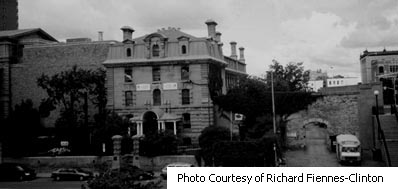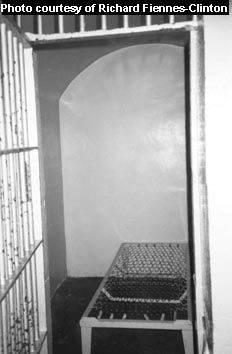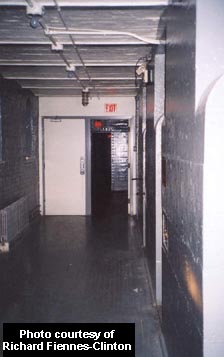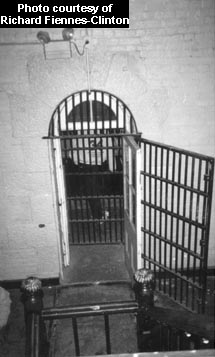Ottawa - Nicholas Street Hostel... A First Hand Perspective...
 |
Exterior of the prison/hostel on Nicholas St |
The Ghost of Patrick James Whelan - By Richard Fiennes-Clinton
At around 11.00 o'clock in the morning, on February 11th, 1869, Patrick James Whelan was hanged for a crime that many contest he didn't commit. He was the alleged murderer of the much loved Father of Confederation, D'Arcy McGee. Many say that he was just a scapegoat, caught up in the public outrage that took on a life of it's own prompted by McGee's violent murder.

The "Haunted Cell" that the ghost of
Whelan is supposed to haunt.
If he was innocent of McGee's murder, then there has rarely been a man who it can be more truthfully said that "he was in the wrong place at the wrong time". A victim of a brutal penal system, he was hanged on a cold February morning in front of a jeering crowd of five thousand. It was one of three "official" hangings to have taken place at the prison on Nicholas Street, in Ottawa.
The prison, now a hostel, is a notoriously haunted site. The stories about this place were amongst the first that I came across when I became interested in ghost stories. It has always had an iconic quality about it, to me; it is in many ways everything that a haunted building should be. It was because of my interest in this sort of legend that I decided to stay there and have a look for myself. Of course, what better time to stay there than the anniversary of Whelan's execution? Of all the spirits which are said to linger here, his is by far the most legendary.

Death Row Hallway
First, I thought it best to review some of the more popular stories surrounding the ghost of Whelan. The most commonly told story derives from a central theme of the apparition of James Whelan, appearing in his death row cell in the middle of the night. He exits the cell, and wanders off to the right, towards the gallows. Some have claimed to hear the words of the Lord's Prayer as the apparition wanders away. These are reported to have been the very words recited as Whelan was led away to die. The death row cell was indeed a room in which one could spend the night, at one time, after the hostel took over the premises. It is no longer available for lodging. The more prosaic reason that is given involves the regulations and restrictions of the local fire department; the bars on the cell remain too restrictive, despite the fact that there is no longer a lock to hold the bars shut.
There are variations on the story of Whelan's apparition, that tell of people being locked in this one cell after witnessing his ghost. Perhaps it is his way of imparting a sense of what he felt as his life drew to a close. Why would this man come back from beyond the grave to live out the last few moments of a tragic end? Why would he inflict his imprisonment on another? Perhaps to relay to the living the sense of injustice that he felt, by making the innocent feel what it is like to be wrongly detained."
With these and other variations of the story in mind, I checked into my room on February 11th, the 132nd anniversary of Whelan's execution. Having left my bags in my room, I decided not to postpone the inevitable, and made my way up the stairs, to where one can access the death row hallway. I carried with me a fairly heavy duty flashlight, and had strapped to my belt my camera case, and another, smaller flashlight ... just in case! I made my way down the hallway to the prison cell, which would have housed the condemned man. It is roughly halfway down the hallway, on the right hand side. I took a few steps into the cell, and considered what it might have been like to live out the end of one's life in such a room. The cell itself is three feet wide, and nine feet deep. Its just large enough for a mattress, and not much else. There was a pervasive sense of sadness in this place, which actually did an admirable job of replacing the fear that I felt.

The Gallows...
Note: Yes, that's a dummy hanging
there in the sweater.
I walked over to where one can look down at the gallows. It's a very short distance away from death row, just a few paces down the hallway and a turn to the left. However, I don't recall ever taking a walk that has left me breathing so tightly. There is a staircase that one comes to, immediately in front of the gallows. The gallows itself is one short flight down. The gallows has two sets of barred doors which prevents the condemned man from fleeing the gallows, back into the building. When the trap door is released, the victim falls into an exposed alcove in an outside courtyard, where any gathered spectators are able to observe the last moments of the execution. In most executions by hanging, the intention is that death comes instantly. The body drops, until the noose is pulled tight, and then the neck is broken. But accidents have been known to happen. One account of the Whelan execution which I've heard, is that death was far from quick.
My attention turned towards the staircase itself. Unlike the building's main staircase, this one has no "cage" to prevent guards from being thrown down the centre. The railings are unusually low; they came up to about the hip. It would be easy for a prisoner to push a guard over the side, in a scuffle, and in fact this did happen in the other staircase.
It is thought, however, that there were several unofficial hangings committed in this stairwell. A wooden beam extends across the top. A rope would have been tied across this and the other end would have been fashioned into a noose, ready for the prisoner's neck. He then would have been thrown over the side and left to hang in the middle of the stairwell, about eight floors up. The victim would dangle until his fingers turned blue, and the body showed obvious signs of death. Then, without any kind of charity at all, the rope would simply be cut and his body would drop down eight floors or so until the corpse hit the floor. How do we know this isn't conjecture? Well, the floorboards at the bottom are dented from the impact of obviously heavy items. And when nearby construction resulted in turning up part of the land around the prison, eleven or twelve skeletons were found. The remains displayed trauma to the neck that would have come as a result of death by strangulation.
Between the gallows, and this staircase, with its murderous applications, there was definitely an invasive sense of darkness that had nothing to do with an absence of lighting.
The "Oven"
This contraption for "unofficial punishment" has been bricked over. It would originally have been, literally, a hole in the wall in which prisoners would be placed naked. An iron door would be drawn over the front, and the prisoner would be locked in for a few days without food or water. Many a prisoner probably died while in "the oven" as it was nicknamed.
Despite the name, no heating device would have been placed inside. There was no environmental control system in the prison at all, from its opening in 1862 until its closing in 1972. There was no furnace, and no air conditioning of any kind.. It would have been hot and muggy in the summer, and frigid in the winter. Even the windows had no glass - just bars.
If inmates did die as a result of these "unofficial punishments" in "the oven" or anywhere else, there would have been similarly unofficial records of it. Their deaths would have been attributed to pneumonia or some other common disease of the day. How do we know about these unofficial practices of prison discipline of the last century? Remember, this prison was open until the 1970s ... guards and former inmates were alive and well when it closed.
We at Torontoghosts and OntarioGhosts cannot thank Richard enough for this report and the great pictures. We also welcome anyone who wishes to do an independent investigation such as Richard to please come forward and tell us what you're planning on doing because we love to share the information. (Please, keep it legal and ethical!)
If you wish to e-mail Richard and ourselves, please This email address is being protected from spambots. You need JavaScript enabled to view it. or contact This email address is being protected from spambots. You need JavaScript enabled to view it.




